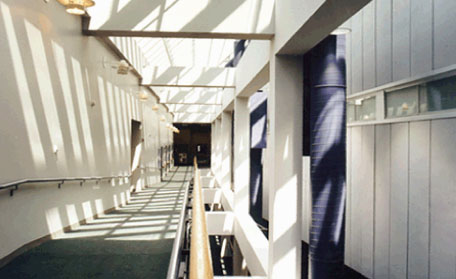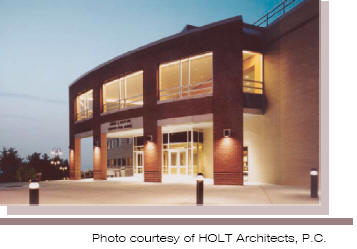











Image courtesy of Brian Genduso. |
 |
James J. Whalen Center for Music
Ithaca College, Ithaca, NY



The James J. Whalen Center for Music is a
69,000 sf addition to the 1964 Ford Hall, on the south side of the Ithaca
College campus in Ithaca, NY.
The building is named for the sixth president of Ithaca College, James J.
Whalen, who passed away in 2001.
The building is designed to be
an all-in-one home for the School of Music at Ithaca College. The school
of music holds a very high profile at Ithaca College, as the college was
founded in 1867 as the ‘Ithaca Conservatory of Music’ and remains one of
the staples of the Ithaca College campus. The new facility contains 30
new faculty studios, a 250-seat recital hall, designed primarily for solo
and chamber music recitals, choral and jazz rehearsal rooms, a
professionally equipped recording studio that will also serve as a
laboratory/ classroom for a new major in audio recording, an
electroacoustic music suite, a music education resource center with an
attached observation room for student teacher preparation, a music
technology classroom and laboratory, a user-friendly library for the
ensemble music collection, and a covered walkway from the upper parking
lot that will provide easier access to concerts and recitals.
The Project Team consisted
of;
Architect and
PM– HOLT Architects, P.C., Ithaca, NY,
www.holt.com
General Contractor – Welliver McGuire, Inc., Elmira, NY,
www.welliver-mcguire.com
Electrical/Mechanical Engineer – M/E Engineering P.C., Rochester, NY,
www.meengineering.com
Structural Engineer – Ryan-Biggs Associates, P.C., Skaneateles, NY,
www.ryanbiggs.com
Owner – Ithaca College, Physical Plant, Ithaca, NY,
www.ithaca.edu
Construction began in December 1997 and
reaction to the building
upon its completion in August 1999 was extremely positive. The
overall project cost was $14.4 million, of which $4.6 million went to
mechanical and electrical systems.
The architecture of the
building exudes an appropriately scholastic feel, yet presents a slightly
higher profile exterior to the surrounding campus. A balance between
education center and performance venue is sought through the use of a
limestone accented brick envelope with sleek dark glass and bright
aluminum framing.
"From the classrooms to the
performing spaces, the teaching studios to the ensemble library, this is
truly a first-class building to house first-rate students and faculty,"
-Arthur Ostrander, dean of the
School of Music
ELECTRICAL:
The electrical supply hookup to the facility is
quite different than most privately owned buildings. Rather than
being fed directly by the utility company, the building must attach to the
pre-existing campus system of electric power distribution. The
campus loops A1 and A2 come into the primary switchgear and is then
distributed to the building, and also to the adjacent Gannett Library.
A total draw of 1050 kVA is possible. There is also an emergency
distribution board fed by a 200 kW natural gas backup generator when the
normal electric supply goes down.
LIGHTING:
The lighting system in this facility is fairly
complex. There are numerous types of lighting loads fed by the
120/208 secondary distribution board including fluorescent, HID and
incandescent. Special lighting systems exist in the performance
halls with IGBT dimmers controlling theatrical halogen lighting and
electronically dimmed fluorescent house lighting. Special attention
must be paid to audible noise from ballasts as any humming or buzzing that
reduces sound quality will not be tolerated.
MECHANICAL:
The mechanical system in this facility is also
fairly simple. Two cooling towers on the roof and a centrifugal
water chiller feed the cooling coils of the AHU's. Two new gas
boilers will make up the extra required load for the heating coil in the
AHU's. Most of the AHU's existed before the addition, and
AHU's 7-10 were added to support separate zones in the new facility. The
new AHU's can support a total fan supply of 80,820 CFM Sound
attenuators were originally specified but were taken out for budget
reasons, but acoustic insulation in the HVAC ductwork was kept as a sound
controlling agent.
STRUCTURAL:
The structural system consists of steel framing and
concrete slabs on metal decks. The steel structure of the addition
interfaces with the existing concrete structure of the Ford Hall in
places, but remains separate when at all possible. The steel structure is
supported by cast in place reinforced concrete foundations, and the whole
building is held up by the ground.
FIRE PROTECTION:
The building has both active and passive fire
protection systems. The building has an emergency sprinkler system.
The steel structure has spray on fireproofing where appropriate. And
the HVAC system has an emergency smoke evacuation mode.
TRANSPORTATION:
There are two Otis elevators in the building.
One is centered on the south side of the facility and accesses all floors
from the ground to the 3rd floor including intermediate levels where
recording studios are placed. This elevator has an increased load
capacity to support the moving of heavy equipment like recording
electronics and pianos. There is another elevator in the elevated
walkway attaching to the parking areas up the hill, to the south, of the
new building. This elevator is primarially for passenger use, and
accesses the parking level, the second level, and the ground level of the
new facility.
TELECOMMUNICATIONS:
As has become common in all educational facilities,
there are as many, or more, internet connections as telephone connections.
RJ-45 internet connections run through the facility and connect to a main
server operated by Ithaca College. Standard campus telephone service
is also installed throughout the facility.
SPECIAL SYSTEMS:
The mechanical system also includes special support
for electronic audio recording and amplification. Analog XLR audio
cables are run through the facility for permanent audio connection between
spaces. Standard 1/4" amplified speaker input cables are installed
as permanent equipment.
Please Note: While great efforts have been taken to provide accurate and
complete information on the pages of this CPEP, please be aware that the
information contained herewith is considered a work-in-progress for this
thesis project. Modifications and changes related to the original
building designs and construction methodologies for this senior thesis
project are solely the interpretation of Benjamin Hagan. Changes and
discrepancies in no way imply that the original design contained errors or
was flawed. Differing assumptions, code references, requirements, and
methodologies have been incorporated into this thesis project; therefore,
investigation results may vary from the original design.
This page was last updated
11/17/2003
This page was created and is maintained by
Benjamin Hagan
This page is hosted by the Department of
Architectural Engineering at Penn State University.
|

